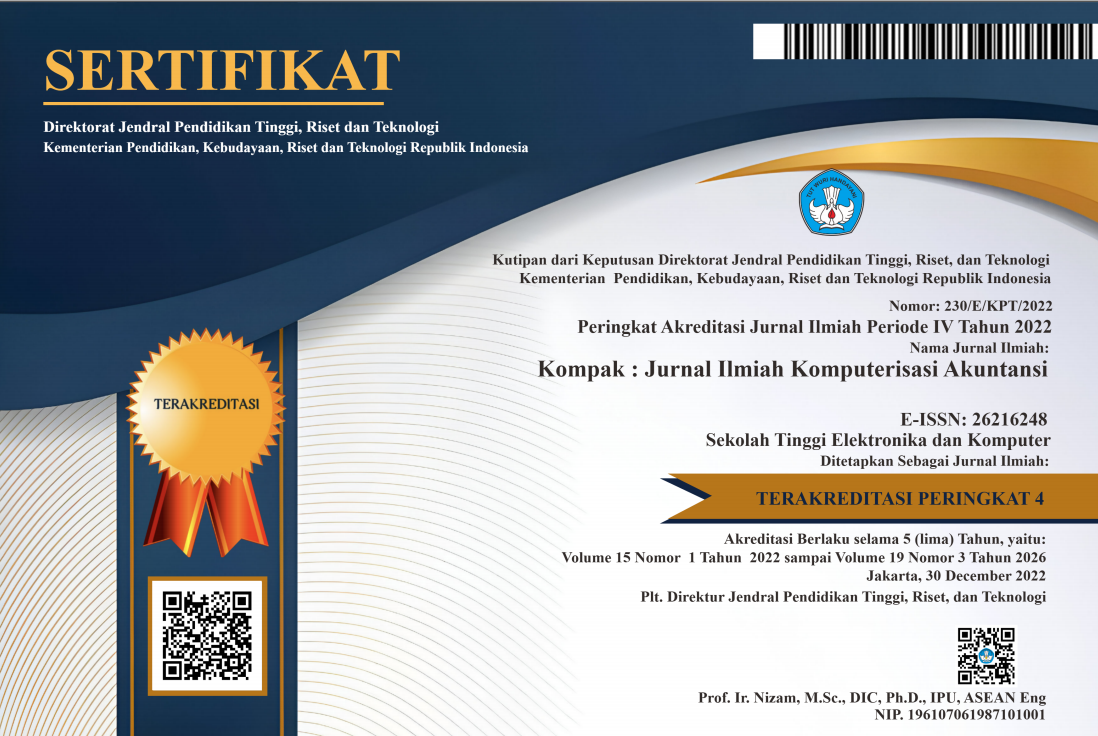Faktor–Faktor Rasio Keuangan Yang Mempengaruhi Non-Performing Loan (NPL)
DOI:
https://doi.org/10.51903/kompak.v17i1.1721Kata Kunci:
Non-Performing Loan, Profitability, Liquidity, Efficiency, Third Party FundAbstrak
This research was conducted with the aim of examining the factors that influence Non-Performing Loan (NPL), such as Return on Assets (ROA), Capital Adequacy Ratio (CAR), Bank efficiency, Diversification Income, Current Account Saving Account (CASA). The population in this research is from the banking subsector listed on the IDX during the period 2018 to 2022, using data from the annual financial statements of conventional banks. The data collection technique in this research uses the Purposive sampling method using secondary data, so that 75 data from 25 companies in the banking subsector in Indonesia are obtained. This research is processed by multiple linear regression analysis using JASP statistical data processing application. The research results can be interpreted that return on assets (ROA) has a negative but insignificant effect on NPL. Capital Adequacy Ratio (CAR), Diversification Income and Current Account Saving Account (CASA) have a negative and significant effect on NPL. Meanwhile, bank efficiency has a positive and significant effect on NPL.
Referensi
[2] Addai, B., Tang, W., & Agyeman, A. S. (2022). Examining the impact of income diversification on bank performance: Are foreign banks heterogeneous? Journal of Applied Economics, 25(1), 1–21.
[3] Akhter, N. (2023). Determinants of commercial bank’s non-performing loans in Bangladesh: An empirical evidence. Cogent Economics & Finance, 11(1), 2194128.
[4] Al Zaidanin, J. S. (n.d.). Determinants of non-performing loans in the United Arab Emirates conventional banks.
[5] Alnabulsi, K., Kozarević, E., & Hakimi, A. (2022). Assessing the determinants of non-performing loans under financial crisis and health crisis: Evidence from the MENA banks. Cogent Economics & Finance, 10(1), 2124665.
[6] Bae, K.-H., El Ghoul, S., Guedhami, O., Kwok, C. C. Y., & Zheng, Y. (2019). Does corporate social responsibility reduce the costs of high leverage? Evidence from capital structure and product market interactions. Journal of Banking & Finance, 100, 135–150.
[7] Bernstein, D. (1996). Asset quality and scale economies in banking. Journal of Economics and Business, 48(2), 157–166.
[8] Brahmana, R., Kontesa, M., & Gilbert, R. E. (2018). Income diversification and bank performance: Evidence from Malaysian banks. Economics Bulletin, 38(2), 799–809.
[9] BTN. (2023). Petunjuk Teknis tentang Provisi & Fee Based Income Kredit Komersial.
[10] Casabianca, E. J. (2020). Credit Supply Response to Non-Performing Loans : Some Evidence From the Italian Banking System. 10(4), 43–67.
[11] Çollaku, B., & Aliu, M. (2021). Impact of non-performing loans on bank’s profitability: empirical evidence from commercial banks in Kosovo. Journal of Accounting, Finance and Auditing Studies, 7(3), 226–242.
[12] Daryanto, W. M., Akbar, F., & Perdana, F. A. (2020). Financial Performance Analysis In The Banking Sector Before And After Financial Technology Regulation In Indonesia (Case Study Of Buku-IV In Indonesia For Period 2013-2019). International Journal of Business, Economics and Law, 21(2), 1–9.
[13] Do, H. L., Ngo, T. X., & Phung, Q. A. (2020). The effect of non-performing loans on profitability of commercial banks: Case of Vietnam. Accounting, 6(3), 373–386. https://doi.org/10.5267/j.ac.2020.1.001
[14] Enjela, L. M., & Wahyudi, I. (2022). Pengaruh Return On Asset, Loan To Deposit Ratio, dan Capital Adequacy Ratio Terhadap Harga Saham. Cemerlang: Jurnal Manajemen Dan Ekonomi Bisnis, 2(3), 78–86.
[15] Ersoy, E. (2022). The determinants of the non-performing loans: The case of Turkish banking sector. International Journal of Insurance and Finance,(2021), 1(2), 1–11.
[16] Fairfield, P. M., & Yohn, T. L. (2001). Using asset turnover and profit margin to forecast changes in profitability. Review of Accounting Studies, 6, 371–385.
[17] Firmansyah, I. (2019). Determinant of non performing loan: The case of Islamic bank in Indonesia. Bulletin of Monetary Economics and Banking, 17(2), 241–258.
[18] Freeman, R. B., & Medoff, J. L. (1984). What do unions do. Indus. & Lab. Rel. Rev., 38, 244.
[19] Gupta, C. P., & Jain, A. (2022). A Study of Banks’ Systemic Importance and Moral Hazard Behaviour: A Panel Threshold Regression Approach. Journal of Risk and Financial Management, 15(11), 537.
[20] Hermanto, H., & Anita, A. (2022). Pengaruh Dana Pihak Ketiga Dan Non Performing Loan Terhadap Profitabilitas Dengan Rasio Intermediasi Makroprudensial Sebagai Variabel Intervening. Jurnal Pendidikan Akuntansi Indonesia, 20(1), 76–87.
[21] Hertina, D. (2021). The influence of current ratio, debt to equity ratio and company size on return on assets. Turkish Journal of Computer and Mathematics Education (TURCOMAT), 12(8), 1702–1709.
[22] Hisar, R., Suharna, J., & Amiruddin, A. (n.d.). Pengaruh Roa Dan Der, Terhadap Return Saham Pada Perusahaan Manufaktur di Bei Yang Go Publik.
[23] Hoggson, N. F. (1926). Banking through the ages. Dodd, Mead.
[24] Husnadi, T. C., Marianti, T., & Ramadhan, T. (2022). Determination of shareholders’ welfare with financing quality as a moderating variable. APTISI Transactions on Management (ATM), 6(2), 191–208.
[25] Hutasoit, D. T. M., Toni, N., & Ariesa, Y. (2022). Effect of loan to deposit ratio, capital adequacy ratio, return on equity, and dividend payout ratio on stock prices with Bank Indonesia interest rates as moderating variables in banking companies on the Indonesia Stock Exchange. International Journal of Social and Management Studies, 3(3), 137–149.
[26] Indrajaya, D., Astuti, M., Maulidizen, A., & Kurniawan, N. (2021). The Effect of Third-Party Funds, Capital Adequacy Ratio, Casa Ratio, Bi Rate, And Inflation Towards The Distribution of Credit Banking in Indonesia. International Journal of Economics Development Research (IJEDR), 2(3), 171–185.
[27] Jensen, M. C. (1976). Reflections on the State of Accounting Research and the Regulation of Accounting.
[28] Khan, M. A., Siddique, A., & Sarwar, Z. (2020). Determinants of non-performing loans in the banking sector in developing state. Asian Journal of Accounting Research.
[29] Kim Quoc Trung, N. (2022). Does leverage fit non-performing loans in the COVID-19 pandemic–evidence from the Vietnamese banking system. Cogent Business & Management, 9(1), 2119675.
[30] Kumar, V., & Kishore, P. (2019). Macroeconomic and bank specific determinants of non-performing loans in UAE conventional bank. Journal of Banking and Finance Management, 2(1), 1–12.
[31] Marchela, F. N., & Widodo, P. (2023). Determinants of non-performing loans in Regional Development Banks (BPD) in Indonesia. International Journal of Research in Business and Social Science (2147-4478), 12(3), 263–271.
[32] Markowitz, H. (1952). The utility of wealth. Journal of Political Economy, 60(2), 151–158.
[33] Mohanty, S. (2021). A comparative financial performance of selected public and private sector banks in India. Parikalpana KIIT Journal of Management, 17(2), 155–174.
[34] Msomi, T. S. (2022). Factors affecting non-performing loans in commercial banks of selected West African countries. Banks and Bank Systems, 17(1), 1.
[35] Naili, M., & Lahrichi, Y. (2022). Banks’ credit risk, systematic determinants and specific factors: recent evidence from emerging markets. Heliyon, 8(2).
[36] Nathania Anindyajati, D. D. H. (2022). Analysis of Determinant Factors of Liquidity Coverage Ratio (LCR) on Conventional Banks in Indonesia Periods 2018–2021. ICONIC-RS 2022: Proceedings of the 1st International Conference on Contemporary Risk Studies, ICONIC-RS 2022, 31 March-1 April 2022, South Jakarta, DKI Jakarta, Indonesia, 201.
[37] Nugroho, I. S., & Endri, E. (2022). Determinants of Non-Performing Bank Loans Listed on The Indonesia Stock Exchange For The 2016-2020 Period. Journal of Social Science, 3(6), 1214–1232.
[38] Ogundipe, A. S., Akintola, D. A. F., & Olaoye, D. S. A. (2020). Interest Rates and Loan Performance of Deposit Money Banks in Nigeria. EPRA International Journal of Economic and Business Review, January, A 13-A 20. https://doi.org/10.36713/epra3014
[39] OJK. (2020). Surat Edaran Otoritas Jasa Keuangan Republik Indonesia Nomor 9/SEOJK.03/2020 tentang Transparansi dan Publikasi Laporan Bank Umum Konvensional.
[40] OJK. (2021). Peraturan Otoritas Jasa Keuangan Republik Indonesia Nomor 12/ POJK.03/2021 tentang Bank Umum.
[41] OJK. (2022). Statistik Perbankan Indonesia 2022.
[42] Okyere, E., & Mensah, A. C. (2022). Macroeconomic and Bank Specific Determinants of Non-performing Loans in Ghanaian Banking Sector. International Journal of Accounting, Finance and Risk Management, 7(2), 40–48.
[43] Rachman, R. A., Kadarusman, Y. B., Anggriono, K., & Setiadi, R. (2018). Bank-specific factors affecting non-performing loans in developing countries: Case study of Indonesia. The Journal of Asian Finance, Economics and Business, 5(2), 35–42.
[44] Radianto, W. E. D., & Kohardinata, C. (2022). Determinant Effect Of CASA and NPM On Market Ratio Of Banks Listed in IDX. Business and Finance Journal, 7(2), 217–237.
[45] Safitri, V. I., & Hendrani, A. (2020). Pengaruh Capital Adequacy Ratio (CAR), Non Performing Financing (NPF), Financing to Deposit Ratio (FDR) Dan Efisiensi Operasional (BOPO) Terhadap Profitabilitas (Return on Assets) pada Bank Umum Syariah yang Terdaftar di Bank Indonesia. JCA of Economics and Business, 1(01).
[46] Saliba, C., Farmanesh, P., & Athari, S. A. (2023). Does country risk impact the banking sectors’ non-performing loans? Evidence from BRICS emerging economies. Financial Innovation, 9(1), 1–30.
[47] Saputra, F. (2022). Analysis Effect Return on Assets (ROA), Return on Equity (ROE) and Price Earning Ratio (PER) on Stock Prices of Coal Companies in the Indonesia Stock Exchange (IDX) Period 2018-2021. Dinasti International Journal of Economics, Finance & Accounting, 3(1), 82–94.
[48] Semia, R. (2019). The determiants of non-performing loans: Do institutions matter? A comparative analysis of the MENA and CEE countries.
[49] Sinaga, J. S., Muda, I., & Silalahi, A. S. (2020). The effect of BI rate, exchange rate, inflation and third party fund (DPK) on credit distribution and its impact on non performing loan (NPL) on XYZ commercial segment bank. Universal Journal of Accounting and Finance, 8(3), 55–64. https://doi.org/10.13189/ujaf.2020.080301
[50] Siswanto, D. J., Maudhiky, F., Wahyudi, I., & Syah, T. Y. R. (2022). The Influence of Debt to Equity Ratio (DER), Return on Assets (ROA) and Company Size on Profit Growth. Journal of Social Science, 3(6), 2137–2147.
[51] Sofianingsih, R. (2022). Pengaruh Diversifikasi Pendapatan, BOPO dan CAR Terhadap aProfitabilitas Perbankan Selama Pandemi Covid-19. Contemporary Studies in Economic, Finance and Banking, 1(2).
[52] Tariq, W., Usman, M., Tariq, A., Rashid, R., Yin, J., Memon, M. A., & Ashfaq, M. (2021). Bank maturity, income diversification, and bank stability. Journal of Business Economics and Management, 22(6), 1492–1511.
[53] Vuong, G. T. H., Phan, P. T. T., Nguyen, C. X., Nguyen, D. M., & Duong, K. D. (2023). Liquidity creation and bank risk-taking: Evidence from a transition market. Heliyon, 9(9), e19141. https://doi.org/10.1016/j.heliyon.2023.e19141
[54] Wahyuningsih, D. (2021). Determinan Faktor Spesifik Bank terhadap Non-Performing Loan Gross dan Non-Performing Loan Net Pada Bank Pembangunan Daerah. JABE (Journal of Applied Business and Economic), 8(1), 102–115.
[55] Weston, J. F. (1991). Some financial perspectives on comparative costs of capital. Business Economics, 33–37.
[56] World Bank. (2023). Bank Nonperforming loans to total gross loans (%).














.png)



